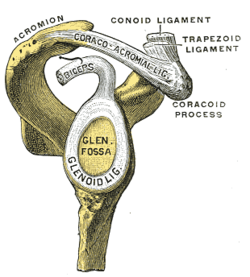Conoid ligament
Appearance
(Redirected from Conoid ligaments)
| Conoid ligament | |
|---|---|
 The left shoulder and acromioclavicular joints, and the proper ligaments of the scapula. (Conoid visible at upper left.) | |
 Glenoid fossa of right side. | |
| Details | |
| From | Coracoid process (scapula) |
| To | Conoid tubercle (clavicle) |
| Identifiers | |
| Latin | ligamentum conoideum |
| TA98 | A03.5.03.006 |
| TA2 | 1749 |
| FMA | 26031 |
| Anatomical terminology | |
The conoid ligament is the posterior and medial fasciculus of the coracoclavicular ligament. It is formed by a dense band of fibers, conical in form, with its base directed upward.
It is attached by its apex to a rough impression at the base of the coracoid process on the scapula, medial to the trapezoid ligament; above, by its expanded base, to the conoid tubercle on the under surface of the clavicle, and to a line proceeding medialward from it for 1.25 cm.
These ligaments are in relation, in front, with the subclavius and deltoid muscles; behind, with the trapezius.
References
[edit]![]() This article incorporates text in the public domain from page 315 of the 20th edition of Gray's Anatomy (1918)
This article incorporates text in the public domain from page 315 of the 20th edition of Gray's Anatomy (1918)
External links
[edit]- Anatomy figure: 10:02-06 at Human Anatomy Online, SUNY Downstate Medical Center
